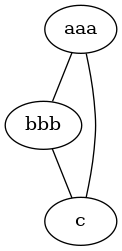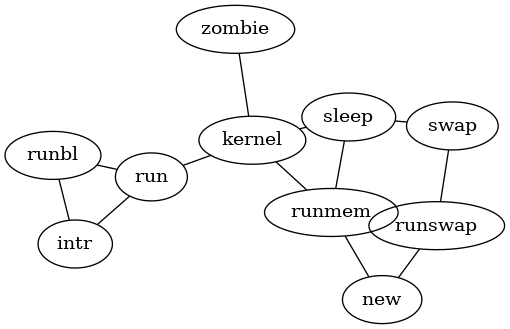Graphviz
Definition
- Graphviz is an open source graph visualization software. It has several main graph layout programs, called layout engines.
- dot
- hierarchical drawings of directed graphs. The layout algorithm aims edges in the same direction (top to bottom, or left to right) and then attempts to avoid edge crossings and reduce edge length.
- neato
- spring model - attempts to minimize a global energy function, which is equivalent to statistical multi-dimensional scaling. See also fdp.
- fdp
- spring model layouts similar to those of neato, but does this by reducing forces rather than working with energy.
- sfdp
- multiscale version of fdp for the layout of large graphs.
- twopi
- radial layouts, The nodes are placed on concentric circles depending their distance from a given root node.
- circo
- circular layout - suitable for certain diagrams of multiple cyclic structures such as certain telecommunications networks
The GraphViz language and command line syntax
Command line syntax
See Command-line Invocation (at graphviz.org).
GraphViz includes several command line commands. The most imporant one is dot
The syntax pattern is:
cmd [ flags ] [ input files ]
Example:
dot -Tsvg GCF2.dot > GCF2.svg
Important flags:
- -Tformat
- -Tformat:renderer
- -Tformat:renderer:formatter
- Defines the output format. You also can choose from a renderer and change the default formatter for the renderer.
- See the list of output formats.
- Most important ones for web pages: png, svg, cmapx (client-side html map), imap (server-side html map) and vrml (partially supported)
- Most important ones for printing: png, svg, ps, pdf
- Most important ones for specialized clients: dot (reproduces the input, along with layout information for the graph), xdot (same with lots of additional information)
- -Klayout_engine
Examples:
- dot -Kneato is equivalent to running neato
- dot -Ktwopi runs the radial twopi engine
- -Gname[=value]
- Defines attributes of the graph like overlaps, fonts, etc.
- -ooutputfile
- specify the output file. Otherwise it's written to default output.
Format, rendering engines, formatters and layout engines
Here are some examples
- Client-side HTML maps
- creates client-side image maps (of course you'll have to attache URLS to either nodes or edges or both)
Example:
dot -Tcmapx -oyour_graph.map -Tpng -oyour_graph.png your_graph.dot
Then use something like:
<IMG SRC="your_graph.png" USEMAP="#mainmap" /> ... [content of your_graph.map] ...
- SVG output using the default dot layout engine
Default use:
dot -Tsvg file.dot
Create SVG output using the cairo renderer and formatter
dot -Tsvg:cairo:cairo file.dot
- SVG output with the twopi engine
dot -Ktwopi -Tsvg GCF2.dot > GCF2.svg
- PDF output with the twopi or fdp layout engines
dot -Ktwopi -Tpdf GCF2.dot > GCF2.pdf dot -Kfdp -Tpdf GCF2.dot > GCF2.pdf
- PNG output
Default use:
dot -Tpng
specifies PNG output produced by Cairo formatted using the GD library:
dot -Tpng:cairo:gd
- xdot output
- Pratical to see where nodes are being positioned so that you can manually change things
- Also useful with graphviz clients
Example:
dot -Ksfdp -Txdot conole-fill-taxonomy-edutechwiki-sfdp.dot > temp.xdot
Some Neato command line examples
Lists configuration
neato -v
List all formats your installation can produce
neato -Tformat:
PNG output without overlap
neato -Tpng -Goverlap=false GCF.dot > GCF.png
SVG output
neato -Tsvg GCF.dot > GCF.svg neato -Tsvg -Goverlap=scale -Gfontsize=8.0 GCF.dot > GCF.sv
Graph files
Graph file syntax
Below is a semi-formal grammar (i.e. the real grammar simplified):
Parentheses ( and ) indicate grouping when needed. Italic square brackets [ and ] enclose optional items. Vertical bars ¦ separate alternatives. Stuff in bold must be typed "as is", e.g. bold [ ... ] square brackets or graph
| graph | --> | (digraph ¦ graph) id {statement-list} |
| statement-list | --> | statement; statement; ... |
| statement | --> | attr-statement ¦ node-statement ¦ edge-statement |
| id | --> | id = id |
| attr-statement | --> | (graph ¦ node ¦ edge) [attr-list ] |
| attr-list | --> | id=id, id=id, .... |
| node-statement | --> | id [ attr-list ] |
| id | --> | quoted string |
| edge-statement | --> | id (-- ¦ ->) id [attr-list] |
- Comments
Are C++ style, i.e. either /* ....*/, // or #
- Identifiers
- Must start with a letter
- Unquoted strings only can contain [A-Z][a-z][0-9] and "_"
- Otherwise strings must be quoted
Graphviz attributes
See either (or both):
We we understood right (this is a disclaimer!)
- You may these (most?) as global settings in the command line
- As global settings in a file
- As "parameter" for each node
- size
- defines the size of the output in inches
- Consult Wikipedia's papersize or ISO 216 articles for pratical tables that translate ISO (European) A,B,C formats to inches.
Example of a portrait A2 page:
size="34.4,16.5";
- ratio
- Is a crucial attribute for larger graphs that should fit on a given canevas size
Example:
- will try to fill a "page" defined by its size.
ratio="fill";
- page
- Defines multiple page outputs (only works with PS)
Example of A3 output (biggest page a typical laser printer can handle)
page="16.5,11.7"
- shape
- Defines the shape of a none
Example of a node redition:
- Remove shape (keep the text only), make it smaller:
node [fontsize=8,shape=none];
- overlap
- determines if and how node overlaps should be remove. There exist several alorithms
Examples:
overlap="false" overlap="prism"
Some dot command line examples
Renders a (default) digraph in SVG with the default formatter
dot -Tsvg GCF2.dot > GCF2.svg
Simple graphviz for mediawiki examples
In this wiki, a directed graph that is represented like this (if you use the graphviz software, you should remove the XML tags).
<graphviz>
digraph G4 {
"Learning theories" [URL="Learning theory"];
"Pedagogic strategy" [URL="Pedagogic strategy"];
"Instructional design model" [URL="Instructional design model"];
"Learning theories" -> "Pedagogic strategy";
"Instructional design model" -> "Pedagogic strategy"
}
</graphviz>
could render like that (yes this wiki has a graphviz extension, but we may not keep it for sure since it is somewhat CPU intensive)

A simple non-directed graph (rendered with neato):
<graphviz renderer='neato' caption='Hello Neato'>
graph G1 {
aaa -- bbb;
bbb -- c;
aaa -- c;
}
</graphviz>
gives:

Or a more complex non-directed graph (rendered with neato):
<graphviz renderer='neato' caption='Hello Neato'>
graph G {
run -- intr;
intr -- runbl;
runbl -- run;
run -- kernel;
kernel -- zombie;
kernel -- sleep;
kernel -- runmem;
sleep -- swap;
swap -- runswap;
runswap -- new;
runswap -- runmem;
new -- runmem;
sleep -- runmem;
}
</graphviz>
like this

Tools
See Graphviz - Graph Visualization Software (a longer list of interfaces, bindings, generators, scripts, etc.). Usually also needs graphviz software and the other way round. I.e. after installing Graphviz, you likely want to install a viewer or generator.
Mediawiki extensions
- GraphViz Widget for Mediawikis (alpha status in Feb 2008).
- Extension:Graphical Category Browser for MediaWiki (>1.7x). This may be outdated.
- http://www.mediawiki.org/wiki/Extension:GraphViz Extension:GraphViz] MediaWiki extension (Tested in this wiki. Worked with Mediawiki version 1.11, Graphviz 2.16.1 on Solaris 10 - DKS/2008)
GraphiViz Viewers
- ZGRViewer. GraphViz/DOT Viewer
- iDot - Incremental Dot Viewer
- "canviz" - HTML5 and Javascript
Installation
- Download of GraphViz software (source and Win/Linux binaries).
- Under Ubuntu I could install it through the package manager (there are quite a lot of dependencies).
sudo apt-get install graphviz
- For solaris, you can download a binary from sunfreeware.com plus these: cairo-1.4.10, freetype-2.3.1, glib-2.14.1, graphviz-2.16.1, pango-1.18.2, xrender-0.8.3,expat-2.0.1.
Tutorials and introductions
- Manual
- Graphviz - Graph Visualization Software Includes both introductions and manuals (the HTML versions on top are better currently - Daniel K. Schneider 14:40, 20 July 2009 (UTC)).
- dot guide
- Introductions
- Graphviz (Wikipedia)
- WikiSchool:Graphviz (Tutorial in German)
- An Introduction to GraphWiz, September 10th, 2004 by Mihalis Tsoukalos, Linux Journal
- Graphviz for UML
- UML Diagrams Using Graphviz Dot. Explains how to create UML class diagrams.